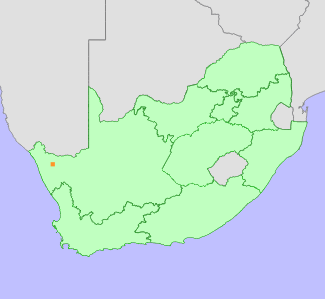|
Scientific Name | Conophytum regale Lavis |
Higher Classification | Dicotyledons |
Family | AIZOACEAE |
National Status |
Status and Criteria | Critically Endangered A4d; B1ab(v)+2ab(v); C1+2a(ii) |
Assessment Date | 2021/12/07 |
Assessor(s) | A.J. Young, P.G. Desmet, I. Ebrahim, D. Guo, A. Harrower, L. Jabar, L. Knoetze, C. Rodgerson, P.C.V. Van Wyk & N.N. Mhlongo |
Justification | This succulent is endemic to the Northern Cape province of South Africa with an extent of occurrence (EOO) and area of occupancy (AOO) of 8 km2. The population is in decline due to illegal collection for the international trade in ornamental succulents since 2019. Illegal collection is likely to increase as there has been a dramatic increase in the number of species and volume of plants targeted since 2019 including many from the immediate area. The continued threat of illegal collection is therefore regarded as very high for this particular species. The single location and very small population size of fewer than 150 mature individuals makes the species very susceptible to very rapid declines. A complete decline of up to 100% of the population is very likely within the next ten years. It therefore qualifies as Critically Endangered under criteria A, B and C. |
Distribution |
Endemism | South African endemic |
Provincial distribution | Northern Cape |
Range | This species is endemic to the Northern Cape province of South Africa where it is only found in a single location with a severely restricted geographic range. |
Habitat and Ecology |
Major system | Terrestrial |
Major habitats | Namaqualand Klipkoppe Shrubland |
Description | This succulent is endemic to the Namaqualand Hardeveld bioregion of the Succulent Karoo biome. The plants occupy a sheltered position in cracks and crevices on large quartz boulders.
This species has a generation length of 30 years. It is expected to be sensitive to the impacts of climate change as it does not disperse and while adapted to arid conditions, is dependent on limited seasonal rainfall. Species in the genus are sensitive to long periods of drought. Drought related mortality has been observed for other closely related taxa within the genus. |
Threats |
| It is currently threatened by illegal collection for the international trade in ornamental succulents. The very small population of plants are severely range-restricted which renders them highly susceptible to a rapid decline in number through collection or other adverse events. As a result a population decline of 95-100% is likely over one generations (30 years).
While it is not possible to model the response of this species to climate change due to its restricted distribution, the average loss to climate change for 15 more widely distributed Conophytum species occurring within the same region is used as an indication of likely impact to this species. Climate models for the likely emission scenarios where emissions stay at present day levels (RCP 2.6) (Hausfather and Peters 2020) and worst case scenarios where emissions continue to increase during the 21st century (RCP 8.5) indicate that there will be a loss of suitable bioclimatic envelope of between 72% and 99% by 2080 for Conophytum taxa within the region. However, as this taxon typically occurs in a sheltered habitat and possesses certain traits likely to afford resilience to xerophytic conditions it is expected to have a level of resilience to climate change and the expected population loss is reduced by 20% to 52%. Species in this genus have limited dispersal ability and migration to suitable habitats elsewhere is regarded as highly unlikely. |
Population |
This species has only been reported from a single quartz ridge. Searches in the immediate vicinity have failed to discover any additional subpopulations. However, photo evidence obtained from poachers suggests that a second site may exist. Just 130 mature individuals were recorded from the only known locality by South African National Biodiversity Institute in 2021. The population is in decline due to illegal collection to supply the international trade in ornamental succulents.
|
Population trend | Decreasing |
Assessment History |
Taxon assessed |
Status and Criteria |
Citation/Red List version | | Conophytum regale Lavis | CR B1ab(v)+2ab(v) | 2017.1 | | Conophytum regale Lavis | Critically Rare | Raimondo et al. (2009) | | Conophytum regale Lavis | Lower Risk - Near Threatened | Victor (2002) | | Conophytum regale Lavis | Rare | Hilton-Taylor (1996) | |
Bibliography |
Hammer, S. 2002. Dumpling and his wife: New view of the genus Conophytum. EAE Creative Colour, Norwich.
Hammer, S.A. 1993. The genus Conophytum: A conograph. Succulent Plant Publications, Pretoria.
Hausfather, Z. and Peters, G.P. 2020. Emissions - the 'business as usual' story is misleading. Nature 577(618-620).
Opel, M.R. 2004. The rediscovery of Crassula alcicornis. Haseltonia 10:38-40.
|
Citation |
| Young, A.J., Desmet, P.G., Ebrahim, I., Guo, D., Harrower, A., Jabar, L., Knoetze, L., Rodgerson, C., Van Wyk, P.C.V. & Mhlongo, N.N. 2021. Conophytum regale Lavis. National Assessment: Red List of South African Plants version 2024.1. Accessed on 2025/11/07 |
 Comment on this assessment
Comment on this assessment


